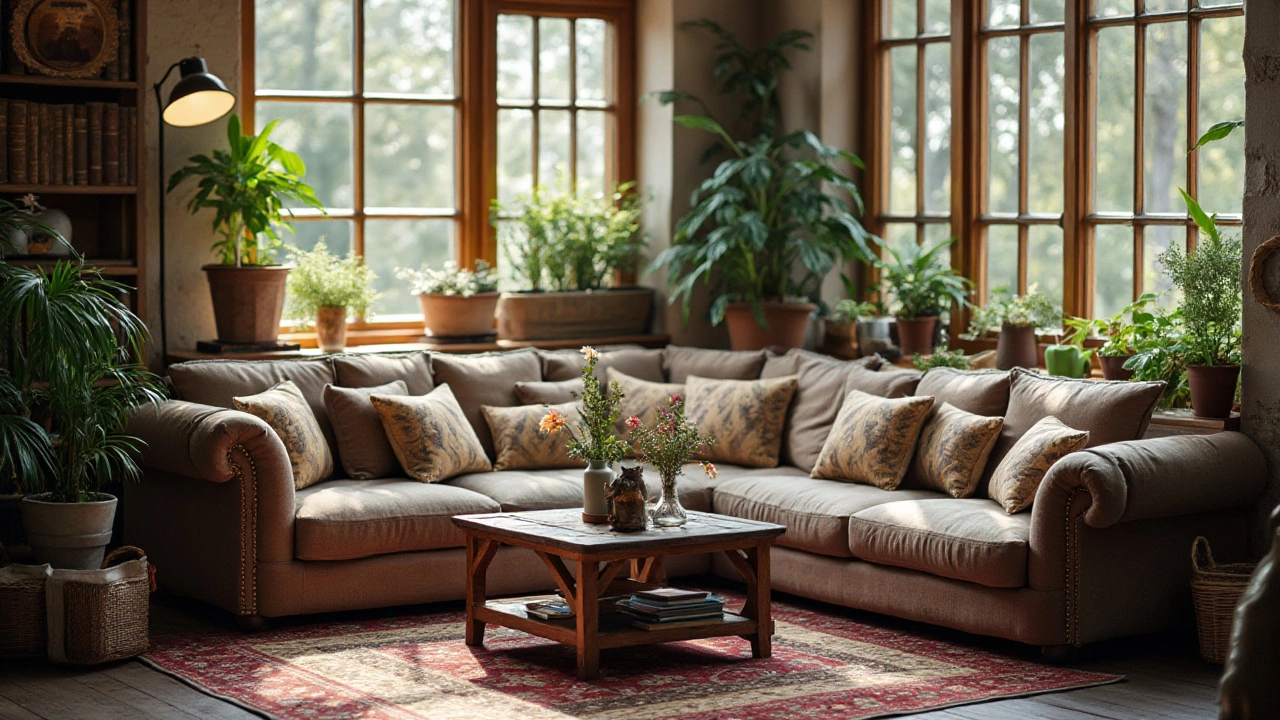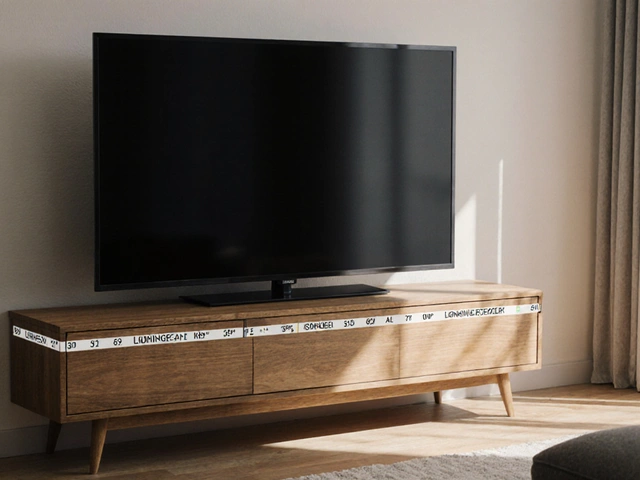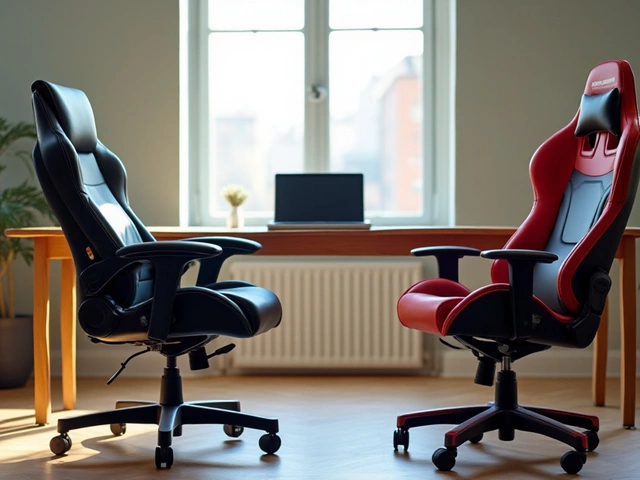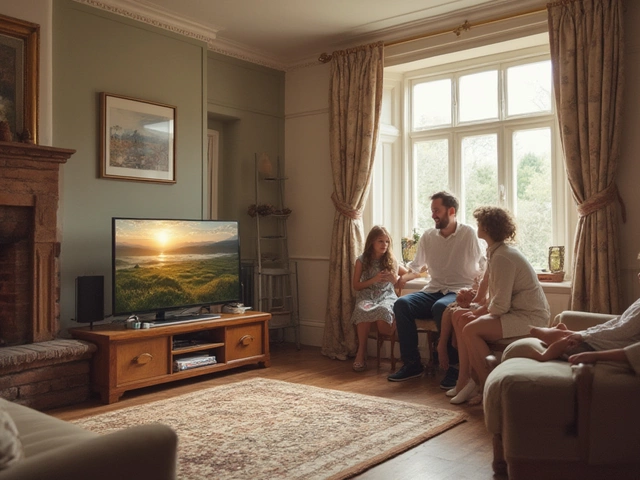When it comes to styling a living room, a corner sofa can steal the show, offering both comfort and an appealing aesthetic. But what should you pair with this versatile piece to ensure your space is not only stylish but also functional? Let's explore some key elements to enhance your corner sofa's appeal.
From the softness of a carefully selected rug that complements your sofa's color, to finding the ideal coffee table that unifies your seating area, there are numerous ways to harmonize your space. With the addition of creative storage solutions, pops of greenery, and the right lighting, you can transform your living room into a welcoming retreat. Let's dive into how each little detail can make a big impact.
- Selecting the Right Rug
- Choosing the Perfect Coffee Table
- Integrating Shelves and Storage
- Adding Greenery with Plants
- Lighting and Accessories
Selecting the Right Rug
When you have a corner sofa commanding attention in your living space, choosing the right rug can make a remarkable difference in the atmosphere of the room. The key lies in harmonizing textures, colors, and patterns to enhance the existing furniture layout. The first step in this process is to consider the dimensions of the rug. Ideally, it should be large enough to tie together the various elements around the corner sofa. A common rule of thumb is for the front legs of your sofa to rest on the rug, which helps in defining the seating area.
Color coordination is pivotal. If your sofa is in a bold hue, opt for a rug in neutral shades to balance the visual weight. On the other hand, a vibrant rug can inject life into a room with a muted sofa tone. It's also crucial to maintain contrast and harmony with other colors in the room, including those on walls, curtains, and additional furniture pieces. One fascinating insight shared by interior designer Nate Berkus is,
"A well-chosen rug acts like a piece of art on your floor. It should tell a story and add depth to a room."Understanding how to create visual synergy is essential for a cohesive look.
Material and texture are equally important. If your living room sees heavy foot traffic, consider durable materials like wool or synthetic fibers that withstand wear and tear while offering comfort underfoot. For a touch of luxury, silk or high-pile rugs can accentuate elegance, though they may require more maintenance. It's beneficial to think about texture contrasts; if your sofa fabric is smooth, a plush rug can introduce a delightful tactile dimension.
Pattern choices should align with your design theme. Geometric designs lend a modern touch, while oriental or Persian rugs provide a classic, timeless feel. Surprisingly, striped patterns can create an illusion of more space, particularly useful for smaller areas. A patterned rug should complement your furniture and art pieces without overwhelming them. To gauge how a rug design will fit, visualize its placement in your room and how it will interact with the existing furnishings.
If you're aiming for a seamless flow, consider layering rugs for a rich, eclectic effect. Start with a larger neutral base and top it off with a smaller, colorful accent rug. This approach adds depth and character to your decor, especially in open floor plans. Layering is also practical; it allows you to highlight specific zones, such as a reading nook adjacent to your corner sofa. Remember to consider the height of the rug pile, as exceedingly high piles can make layering challenging.
Choosing the Perfect Coffee Table
In the charming world of living room decor, picking out the ideal coffee table can make all the difference in fostering a harmonious atmosphere that marries aesthetics and practicality. When faced with an array of shapes, sizes, and styles, it can be overwhelming to zero in on the perfect coffee table for your corner sofa ensemble. A pivotal piece in the room, it not only serves its utilitarian role but also enhances the visual narrative of your space. Whether you lean towards a classic wooden tabletop or a more contemporary glass design, understanding the nuances of each choice can steer you towards making an informed and personal decision.
Begin by considering the general shape of your living room and the spatial dynamics around your corner sofa. Rounded coffee tables, for instance, can soften the straight lines of a sectional, creating a sense of flow and openness. Conversely, if your space is relatively large, a rectangular or even a square table can provide a solid anchor, drawing the eye and creating a balanced proportion with the sofa. According to renowned interior designer Joanna Gaines, "A well-chosen coffee table strikes a balance between functionality and form, fostering a living room both inviting and serviceable."
The coffee table should be at about 18 inches from the sofa, granting ample room to navigate without strain. This standard distance is not merely a guideline but a tested arrangement for ensuring comfort and ease.
Parallelly, the height of your coffee table is of concern. Typically, your table should align closely with the seat height of your sofa or slightly lower to sustain a seamless transition of lines and maximize accessibility. While colors and finishes reflect individual taste, staying within the same color scheme or choosing complementary hues can harmonize the entire setup. A wooden table can radiate warmth, while a metallic or reflective surface can introduce a modern flair. Materials like glass and metal also tend to create an illusion of space, which is advantageous for smaller rooms.
The Multifunctionality Factor
When you evaluate the role of your coffee table, let its functionality guide your choice. For those who like to entertain, a sturdy spot to place drinks might take precedence. Families might benefit from a table with rounded edges for safety, while spaces shared by reading enthusiasts might require tables with built-in storage or a second tier for keeping books and magazines. Considering these day-to-day needs prevents buyer's remorse and ensures that your choice remains practical long after the excitement of a new purchase fades.
For example, somewhere back in the early 2000s, the trend of nesting tables arose—a fantastic solution for limited spaces. They allow you to expand or minimize your surface area according to your immediate needs. Additionally, they introduce an element of whimsy as one unit designed to function as several. Following this trend, manufacturers have expanded their designs to incorporate additional features like drawers or lift-top centers, providing unexpected storage solutions in tight spaces.
Finally, balance creativity with intention. The right table should resonate with your personal style yet suit the lifestyle you live. Whether it’s a minimalist Scandinavian design, a robust industrial piece, or a shabby chic find from a flea market, it's about creating authenticity in your living area, reflecting a part of you that feels genuine and uncontrived. Armed with these insights, you can navigate the coffee table selection process with confidence, ensuring the heart of any living room—the cherished spot by your corner sofa—beats with style and function.
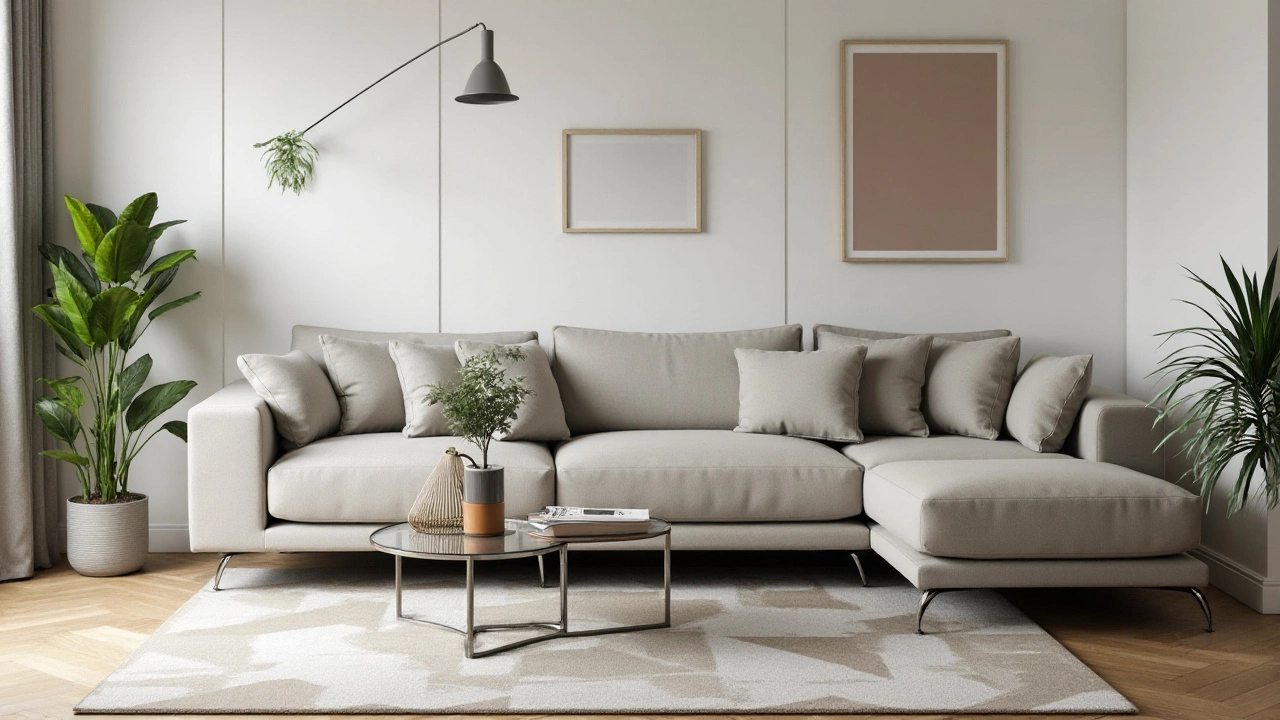
Integrating Shelves and Storage
The incorporation of shelves and storage units alongside a corner sofa not only maximizes space but also brings both beauty and function into your living room. A well-placed shelf can serve as home to your cherished books, a mix of photo frames, or even a series of decorative artifacts that express your personality. When placed carefully, these shelving units can turn an ordinary corner into a focus point that draws the eyes of your guests.
Consider floating shelves for a modern, airy touch—these not only conserve floor space but create a visually intriguing layout that feels light and contemporary. They are perfect for displaying delicate items like succulents or collectibles.
"Good design is making something intelligible and memorable. Great design is making something memorable and meaningful," states Dieter Rams, a revered figure in product design.When it comes to placing shelves, it’s important to consider the height. Hanging them too high can leave the room feeling empty, while placing them too low might make the space crowded. The sweet spot is generally around eye level for most installations.
Hidden storage solutions can also play a key role in elevating the synergy between practicality and aesthetics. Think multi-functional pieces like a storage ottoman or a coffee table with hidden compartments. These clever pieces provide additional storage without sacrificing style, keeping your living room tidy and free from clutter.
One idea worth exploring is utilizing the vertical space around your corner sofa by installing tall shelving units on either side. This not only frames the sofa but also gives you ample room to store bigger items or display larger decorative elements. When arranged symmetrically, they create a balanced atmosphere that makes your space more inviting.
Lastly, incorporating baskets or boxes on shelving units can help in organizing smaller objects that you prefer to keep out of sight. These can hold anything from magazines to blankets, allowing you to maintain a clean and organized environment. Using subtle, neutral tones for these storage accessories can subtly tie together the color scheme of the room.
If you’re willing to get crafty, consider custom-built shelving to perfectly fit your space. Tailored solutions ensure no inch is wasted and can blend seamlessly with the overall design scheme of your living room. Investing in quality materials like real wood or metal will pay off by keeping the furniture sturdy and timeless.
Adding Greenery with Plants
The subtle, yet impactful addition of greenery can transform a living room with a corner sofa into a tranquil space that feels both refreshing and invigorating. Plants do more than just beautify; they purify the air and provide a calming influence on the room's ambiance. When choosing plants, consider the lighting conditions in your living room. For a cozy setup with indirect sunlight, types like pothos or snake plants are ideal. Both are hardy and thrive without too much fuss, perfect for the corner of your room where light may not always be at its best.
Placement is everything when it comes to integrating plants with your interior design. Positioning a tall, leafy plant like a fiddle leaf fig or a palm in the corner can help frame your corner sofa. This not only softens the angles but creates a natural flow within the room. For tabletops, smaller succulents or terrariums add a touch of nature without overwhelming the space. Hanging plants can also be a whimsical addition, introducing levels to your design and drawing the eye upwards.
"Houseplants are more than home decor; they are living organisms that interact with your body and mind, enhancing your quality of life," quotes Dr. Fraser Torpy, director of the University of Technology Sydney, Plant and Indoor Air Quality Studies Group.
Consider using varied planter styles to add character and charm. Concrete pots lend a modern and industrial look, while woven baskets bring warmth and texture. By choosing planters that complement the aesthetics of your living room, you'll create a more cohesive and inviting atmosphere. Don't forget to think about the arrangement of your plants. Clustering multiple small plants together can make a bold statement, whereas a standalone large plant can act as a sophisticated focal point.
Climate and Care
Keeping in mind the climate and care of each plant is key to maintaining a vibrant and healthy plant display. Make sure to select species that match your ability to nurture them; if you're new to plant care, opt for low-maintenance species that are forgiving of a missed watering or two. Generally, studies suggest that keeping a variety of different plants can be beneficial, not only for the appeal but also for diversifying the natural filtration benefits they provide.
Whether your aim is to create a leafy sanctuary or just to add a little color, integrating plants around your corner sofa can dramatically uplift the mood and feel of your living space. It's a small change that yields big rewards, turning your home into a living work of art while boosting well-being.
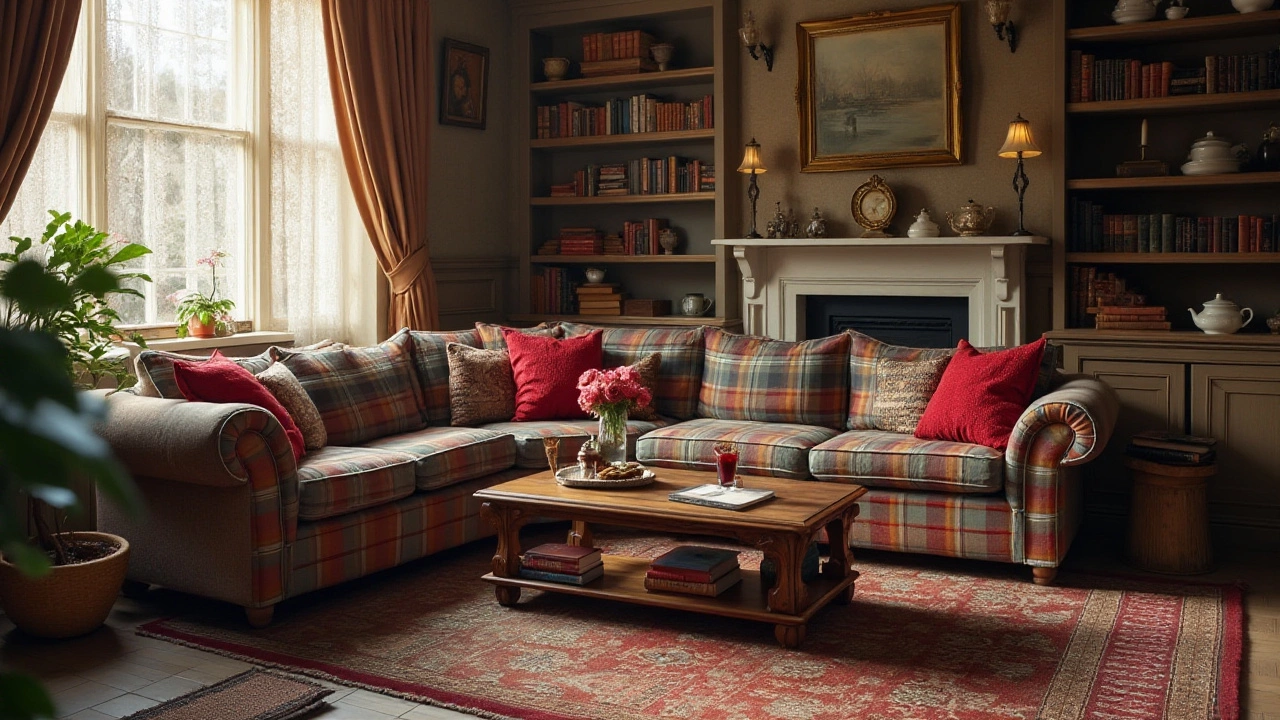
Lighting and Accessories
When it comes to crafting the perfect living space, choosing the right lighting and accessories is essential. These elements not only accentuate your corner sofa but also set the tone and mood of the room. The strategic use of lighting can highlight the stunning features of your sofa and create a sense of warmth and coziness that draws people in. Ambient lighting, such as floor lamps or ceiling fixtures, provides an all-encompassing glow that fills the room, while task lighting, like reading lamps or adjustable wall sconces, focuses on specific areas, allowing for activities like reading or knitting.
The beauty of light fixtures lies in their versatility and the opportunity they provide to express personal style. From sleek, contemporary designs to ornate and traditional choices, the lighting you select tells a story. Imagine a mid-century modern lamp casting soft pools of light that create small sanctuaries within the room, isolating the intimacy of your seating arrangement from the world outside. The impact of layered lighting, which mixes different light sources within the same space, can enhance both the aesthetic and practical aspects of the room. According to interior designer Bobby Berk, "Lighting can really affect your mood and productivity, so it's important to choose wisely."
Bobby Berk's insight reminds us how vital lighting choices can be to both comfort and functionality.
Accessories, on the other hand, are like the personal touch you add to the space. Think of them as the jewelry of the room, providing color, texture, and personality. Accessories come in all shapes and sizes, from throw pillows that introduce a burst of color to artworks that define the walls around your corner sofa. When selecting accessories, consider their texture and how they complement or contrast with your sofa fabric. Natural materials like wool, cotton, or even jute can add layers of texture that invite tactility. Meanwhile, metallic accents such as mirrors or picture frames can echo the lines of modern interiors, balancing soft textiles with their reflective surfaces.
You might choose to incorporate a range of accessories to create a cohesive look. Begin with a color palette that complements your corner sofa, selecting hues and finishes that either harmonize or offer a bold contrast. Pay attention to scale, ensuring that each piece feels proportionate within the space. Too many small items can clutter the room, while large objects might overwhelm it. For a harmonious blend, stick to an odd number of accents; it's a tried-and-tested design rule that often yields visually pleasing results.
Let's take a closer look at how you might layer these accessories to create depth and dimension. Start with foundational pieces like a textured area rug, which anchors your corner sofa and defines the seating area. Add throw blankets draped over the back of the sofa for comfort and visual warmth. Arrange decorative cushions that echo the colors found in nearby artwork. You may place a sculptural object or two on the coffee table, serving as conversation starters and focal points.
Ultimately, lighting and accessories are finishing touches that highlight and celebrate the unique features of your home while personalizing it to reflect who you are. They transform a simple corner sofa into the centerpiece of a lively, welcoming living room. Embrace creativity, trust your instincts, and understand the subtle power these elements wield in creating the perfect living space. Your choice of lighting and accessories might seem minor, but they hold the key to making your living room a true reflection of your personality and lifestyle.
